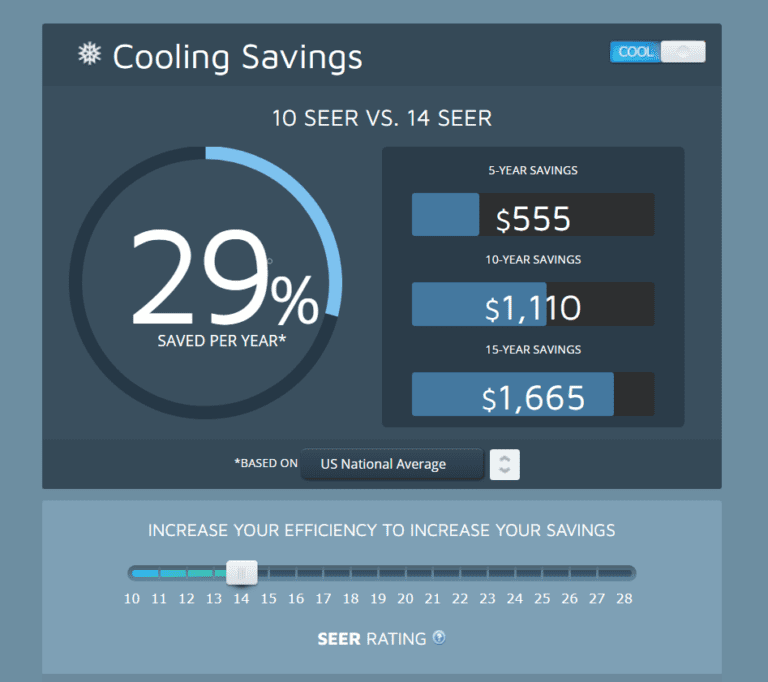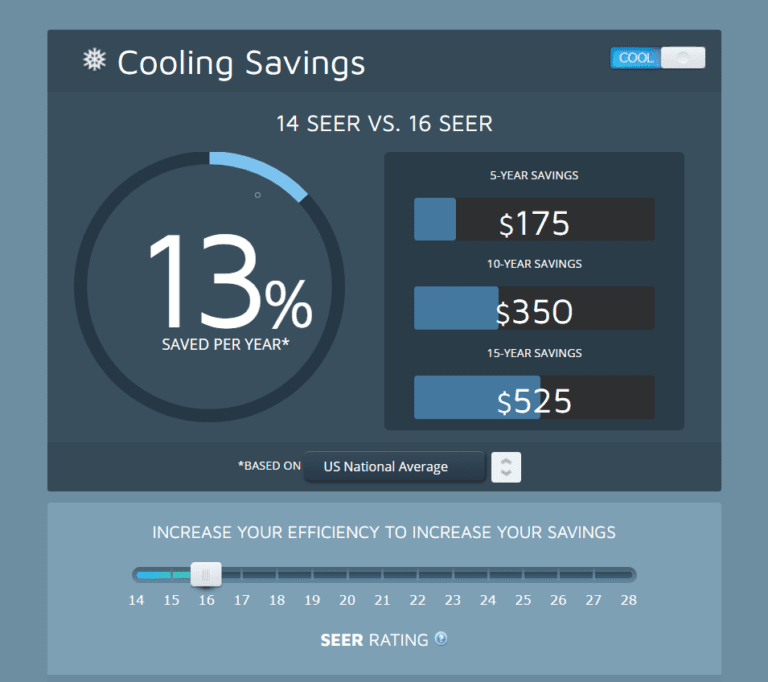Many people who plan on getting a new air conditioner often have to face this dilemma: “Should I pay for an energy-efficient unit with a higher cost or settle for a more budget-friendly option?”
If you’re having this problem, our experts at Service Emperor can help you choose between 14 SEER versus 16 SEER units, two of the most popular choices among Georgia property owners.
Let’s go over these two options, their benefits, and what might make the best fit for your home or business.
What Is SEER?
If you don’t exactly know what SEER stands for, it’s an acronym for Seasonal Energy Efficiency Ratio.
This value represents the cooling yield of a specific unit divided by the amount of electricity needed to produce it. In other words, a higher SEER means higher efficiency and more energy savings for you.
Energy Star measures the air conditioning and heat pump cooling efficiency of HVAC models and gives SEER ratings to help the purchasing decisions of consumers like yourself.
Why should you go for a lower 14 SEER unit over a 16 SEER unit then? In some cases, choosing a less efficient HVAC unit might be the better option. Let’s see why.
14 SEER Air Conditioner

Many consider 14 SEER as the baseline for energy efficiency because the federal government requires all newly produced AC units to have this minimum rating.
Don’t be fooled, though, because even 14 SEER air conditioners offer 20% to 30% lower electricity costs than the average cooling system used 15 years ago. Most units in the past only had an 8 or 9 SEER rating, making a baseline 14 SEER still very efficient.
If you’re planning to replace a very outdated AC system, then getting a 14 SEER model will already create a substantial drop in your energy bills. These AC units are often less expensive, so you don’t have to worry as much about the upfront costs. With that said, when should you consider investing in a 16 SEER unit or an even higher SEER rating?
16 SEER Air Conditioner

Higher SEER-rated air conditioners are more expensive because they use the latest two-stage compressor technology to reduce energy usage, eliminate more humidity, and lower their carbon footprint. While they have a higher initial cost than their 14 SEER counterparts, installing a 16 SEER AC unit might be more cost-effective when you factor in long-term savings.
Systems with a 16 SEER rating are 13% more efficient than those with a 14 SEER rating, saving you hundreds of dollars in energy costs over several years. To put things in perspective, switching to a 16 SEER unit will save you roughly $13 for every $100 spent running a 14 SEER system.
These two factors will largely determine how much you can save with an energy-efficient 16 SEER unit:
- Unit size: The more extensive your property, the bigger the HVAC units you need to cool it. Bigger air conditioners will use up more power and cost more to run.
- Cooling needs: 16 SEER air conditioners are ideal if you need them on for most of the day because their energy efficiency rate increases with usage.
How To Calculate Your Energy Savings
Is a higher SEER worth the price difference? If you want to know your potential savings with a 14 SEER vs. 16 SEER air conditioner, you can follow these five easy steps.
1. Know Your Energy Costs
Check the statement on your energy bill for a breakdown of your electricity costs. If you don’t have it on hand, you can usually find this information on your power supplier’s main website.
Sometimes, the bill won’t display your costs in plain dollar amounts. Instead, they might show it as part of an equation: kWh (kilowatt-hours) multiplied by the price of electricity. As an example, 700 kWh at roughly 10 cents will approximately cost you $70.
2. Find Your Required Cooling Output or AC Unit Size
If your old AC unit met your property’s needs, you can use its output as the baseline for your new air conditioner.
Check its body for a metal tag that shows the cooling capacity. The number you find will usually indicate the BTUs of heat it can remove from indoors by the hour under normal conditions. You can also get this information from your owner’s manual or the manufacturer’s website.
If you just moved to a new property or made some significant renovations, we recommend getting one of our experts to conduct a load test and accurately assess your required output.
3. Check Your Area's Average AC Unit Usage (In Hours per Year)
Knowing your specific property’s annual AC unit usage might be challenging, but we can settle for your area’s average instead. You can check this statistic on the US Energy Information Administration website.
After finding your city’s average number of yearly AC usage, you now have everything you need to determine your savings with a 14 SEER vs. 16 SEER.
4. Calculate Your Annual Power Costs
You can use this equation to determine the energy cost difference between a 14 SEER AC and a 16 SEER AC:
BTUs / SEER rating X Average AC Usage / 1000 X Electricity Costs = Predicted Annual Cost
Dividing by 1000 will give the kilowatt-hour rate instead of watt-hours. This value is much easier to assess and compare since your electricity bills use kilowatt-hour readings.
Or you could just use the handy SEER calculator below.
5. Compare the Seasonal Energy Efficiency Ratio Costs
When you’ve calculated your 14 SEER vs. 16 SEER annual costs, the only thing left to do is compare them. Simply subtract the value of the 14 SEER unit and the 16 SEER unit to determine your energy savings each year. Is it worth the pricier 16 SEER AC system?
As with any form of building improvement, you need to consider how long you plan to use your property. 16 SEER units or air conditioners with even higher ratings can offer significant savings on your energy bills, but it might take a few years to offset the difference in upfront costs. 16 SEER units also provide much better comfort because of their two-stage compressors.
With all of this taken into consideration, a new AC system with an excellent SEER value can also give your property a marketing edge in Georgia’s competitive real estate market.
14 SEER vs. 16 SEER Unit: Conclusion
There are many factors you have to take into account when choosing between different SEER ratings. You can find a big difference in savings for a larger property when you pick a high-efficiency 16 SEER air conditioner.
On the other hand, 14 SEER AC units are often enough to service smaller indoor areas. They remain a solid choice if you plan to upgrade your very outdated air conditioning system while sticking to a tighter budget.
Do you need some help deciding between a 14 SEER vs. 16 SEER AC? Here at Service Emperor, we have assisted many homes and businesses in Pooler, GA—and now, it’s your turn. Our team of professionals can evaluate your property to see whether you need a 14 SEER unit or a 16 SEER unit.
After our evaluation, we can offer you some potential options that deliver the best performance while saving you money in power costs. Additionally, we can keep your HVAC system running at peak performance throughout the year with our maintenance solutions. Reach out to our experts by calling (912) 231-5430 today!

